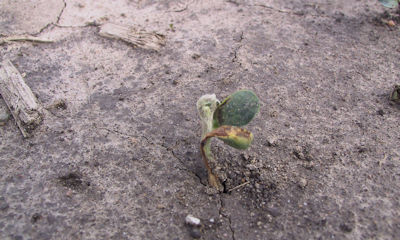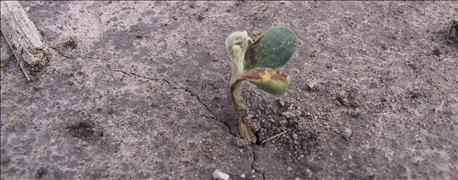
Cost apparently triggered some of you to buy untreated soybean seed this year. That’s the report coming in from the country.
If you’re planting untreated soybean seed, here’s what the panel of Indiana Certified Crop Advisers suggest keeping an eye out for. The panel includes Jesse Grogan, agronomist, LG Seeds, Lafayette; Greg Kneubuhler, owner of G &K Concepts, Harlan; and Tom Stein, manager of the Boswell/Templeton branches for Ceres Solutions.
Question: I elected not to treat soybean seed this year. I usually plant in early to mid-May. What kind of thing should I be looking for, and what can I do if I find it?

EYES WIDE OPEN: If you go without treated seed this year, the Indiana Certified Crop Adviser’s panel suggests keeping an eye out for problems. This seedling is affected by rhizoctonia. (Photo courtesy of Kiersten Wise, Purdue University Extension)
Grogan: Entire fields should be scouted after emergence. Evaluate plant populations to ensure stands are adequate. They should not be below 100,000 plants per acre or have gaps of two to three feet in the rows at the V1 growth stage. If plant populations are low it would require overseeding thin areas with the planter running at an angle to the original row direction. The goal would be to improve stands to about 140,000 plants per acre.
Kneubuhler: As someone who doesn’t sell seed or seed treatments, we highly recommend having soybeans treated. We’ve evaluated seed treatments many times over the years, and have seen too much consistency in payback for treating to recommend pulling that from the budget- even in our current pricing situation.
Stein: As far as insects go, look for bean leaf beetles, Mexican bean beetles, cutworms, wireworms, seed corn maggots, white grubs, leaf hoppers, thrips and soybean aphids. You should also be on the lookout for soybean cyst nematodes.
There are several insecticide rescue options to control aboveground pests.
Grogan: Reduced plant stands can be caused by a number of factors, including fungal seedling rots such as pythium, rhizoctonia, soil compaction due to wet commodities and hard rains before emergence.
Kneubuhler: What to look for depends upon which treatment you went without on the seed. Is it fungicide, insecticide, nematicide or all of them? Each one would require different things to look for if you didn’t treat. For example, if you left out fungicide, it could be phytophthora root rot. If you didn’t include a seed insecticide, it might be bean leaf beetle.
Stein: There are several insecticide rescue options available to control above ground pests. Also be looking for seedling fungal diseases such as Pythium, which is the greatest threat to soybean seedlings in the Midwest. Others include phytophthora, rhizoctonia and fusarium. Unfortunately, if you have fungal disease problems, sometimes the best rescue treatment is to replant.
Kneubuhler: I could concur that later plantings can sometimes ‘get by’ without a seed treatment. If the majority of planting is mid-May or later, it may be a risk worth taking. For most cases, however, omitting certain seed treatments is a risk I wouldn’t take.
About the Author(s)
You May Also Like




